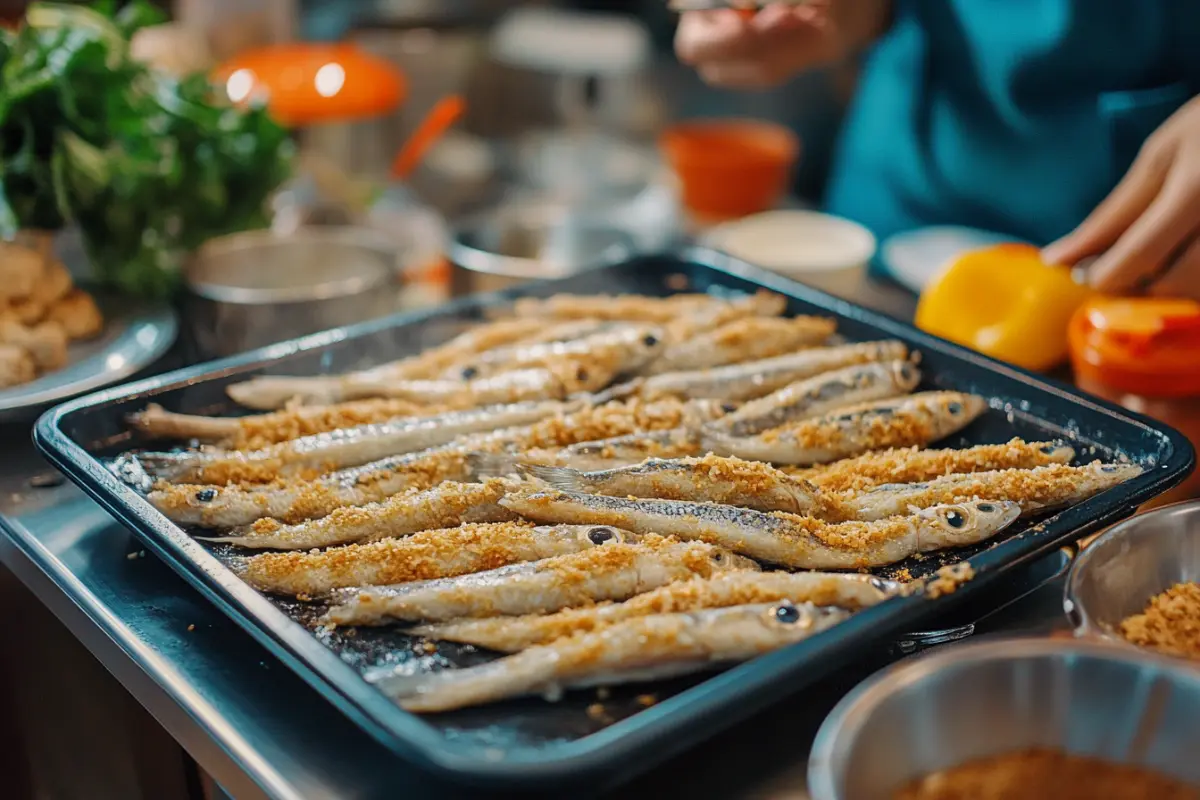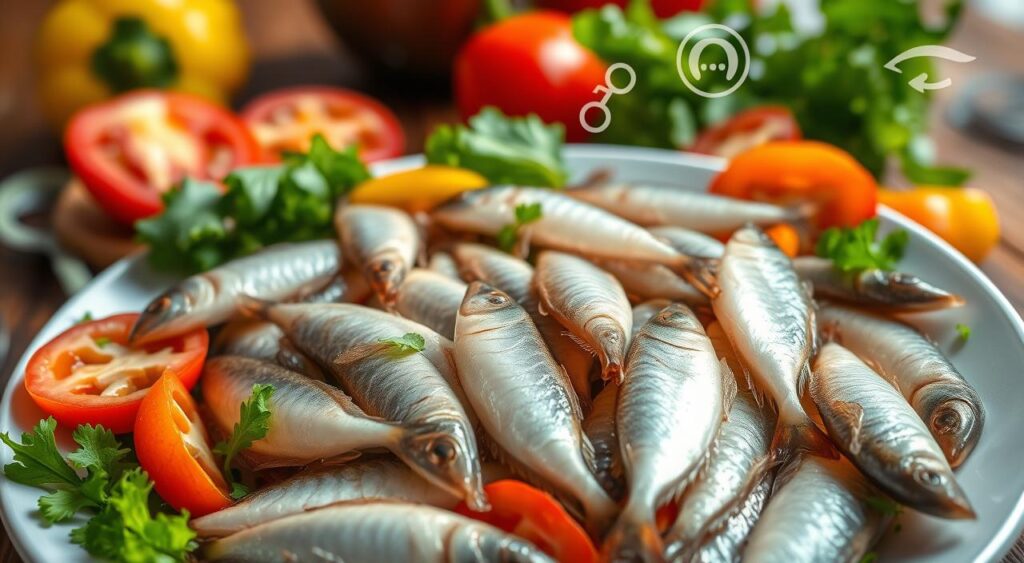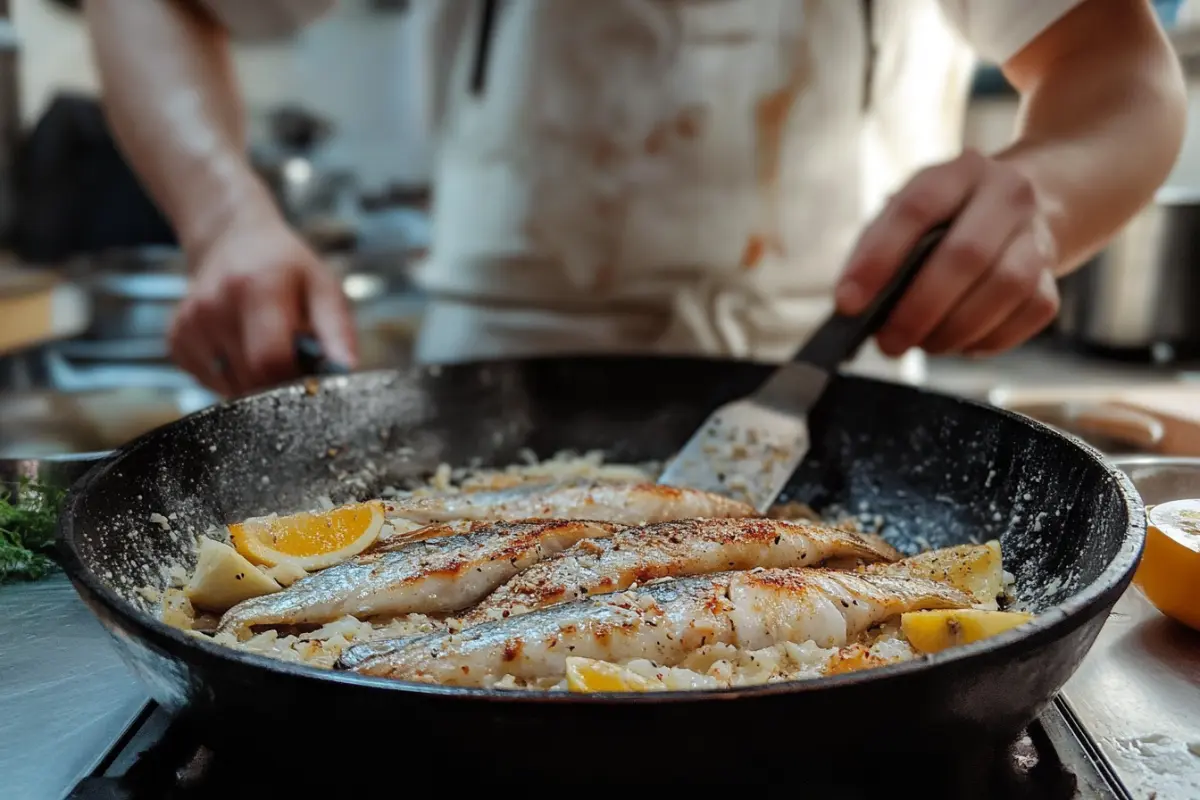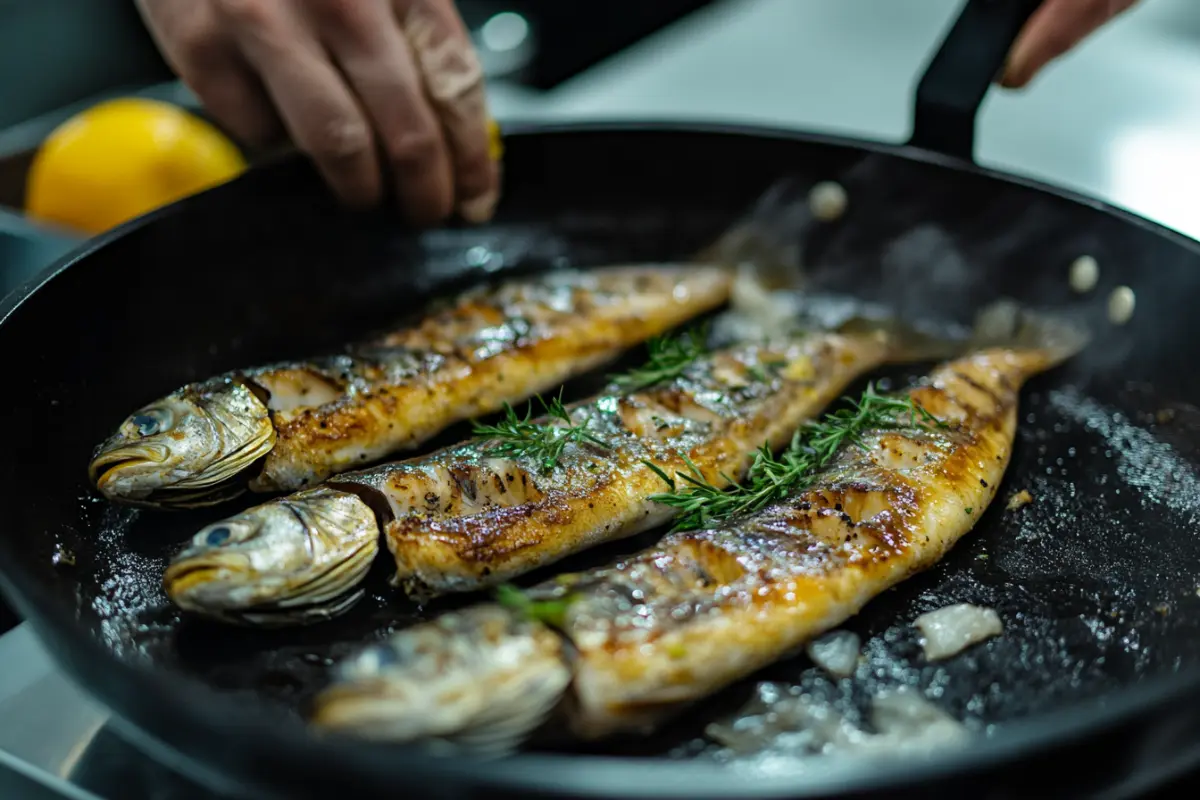I’ve always been drawn to whitebait fish, those small, shiny creatures. They’ve become a big hit in the world of seafood. Let’s dive into the world of whitebait fish and explore why people love them so much.
they are the young fry of different fish, usually 25 to 50 millimeters long. They swim in schools along coasts and into estuaries. In many places, they are seen as a special treat, especially in New Zealand.
In New Zealand, people eat them whole, including the head and bones. This guide will take you through the world of whitebait fish. We’ll look at their species, nutritional value, and how they’re caught and cooked. Get ready to learn about these tiny sea wonders.
What is Whitebait: Understanding These Tiny Treasures

It refers to the young stages of many fish types. These small, clear creatures live in coastal waters and estuaries globally. They include sprats, herrings, sardines, anchovies, and New Zealand’s galaxiid fish.
Different Species of Whitebait Fish
In New Zealand, the main whitebait are five galaxiid species. These are inanga, koaro, banded kokopu, giant kokopu, and shortjaw kokopu. They are 45-55mm long and 15-22 weeks old when they come back to rivers and streams.
Physical Characteristics and Size
Whitebait look like tiny, delicate fry and are small. They are usually clear or silver, making them hard to see in the water. Their size, about 5 centimeters, shows how short their lives are.
Natural Habitat and Distribution
Whitebait live in coastal waters and estuaries worldwide. They are born in freshwater, go to sea, and return to rivers and streams in spring. This journey has fascinated people for centuries.
“Whitebait are tiny, delicate fish, often sprats or young herring, caught in coastal waters.”
The Nutritional Value of Whitebait

Whitebait, a small fish, is packed with protein and essential nutrients. It’s a healthy and versatile food for any diet. It’s great for boosting your nutritional benefits or just enjoying a tasty seafood dish.
Raw whitebait has 153 kcal (640 kJ) of energy per 100 grams. It also has 8.3 grams of fat and 18.3 grams of protein. But, when fried, it gets 295 kcal (1228 kJ) per 100 grams. This cooking method might change the nutritional balance a bit.
“Whitebait is a true nutritional powerhouse, offering a wealth of essential nutrients in a tiny package.”
It’s always a nutritious choice, full of protein and vitamins and minerals. The exact nutrients can vary by species and where it’s caught. But, its health benefits are always there.
Eating whitebait can boost your health, giving you a good amount of protein and other nutrients. You can have it fried, baked, or in a tasty dish. Its nutritional benefits make it a favorite for seafood lovers and health fans.
Global Whitebait Fishing Industry
The global whitebait fishing industry covers many areas. Major fishing spots are in the Baltic Sea, Black Sea, and New Zealand’s coasts. Whitebait, young forms of herrings and small fish, are a big catch. They are worth around 400,000 tonnes a year, but most is used for industrial purposes, not eating.
Seasonal Availability
In New Zealand, you can fish for whitebait from September to October. The Chatham Islands have a longer season, from December to February. It’s important to eat them right away because their quality drops if they sit around.
Commercial Fishing Methods
Commercial whitebait fishing uses different methods. Fine-meshed nets, scoop nets, sock nets, and set nets are common. These help catch the small fish without harming them too much. But, worries about the fish’s future have led to fishing limits in many places.
“Whitebait are considered very juvenile herrings, often cooked by flouring and deep frying, commonly seen as fishy starters in some restaurants.”
The global commercial fishing for whitebait and similar fish is big. It’s important for food and the economy. People love the special taste of these tiny fish in many dishes worldwide.

Traditional Preparation Methods and Recipes
Whitebait, those delicate and flavorful tiny fish, have inspired diverse culinary traditions around the world. In New Zealand, the beloved whitebait fritters are a popular way to savor these aquatic treasures. They are made by combining the fresh whitebait with eggs, creating an omelette-like dish that is a true delight.
In the UK, deep-fried whitebait is a classic pub snack. It’s often served with a squeeze of lemon juice and a side of bread.
The Italian cuisine also celebrates the joy of whitebait, featuring the beloved gianchetti. These lightly boiled whitebait are dressed with a simple dressing of olive oil and lemon juice, or transformed into crispy fritters. Down in Sicily, the whitebait finds its way into the popular polpette di neonata, a type of croquette that showcases the versatility of these tiny fish.
“Whitebait is a staple in cuisines such as those in Iceland and the UK, where it has been a favorite pub snack for generations.”
Whether you prefer the whitebait fritters of New Zealand or the deep-fried delights of the UK, these traditional preparation methods and recipes are a testament to the enduring appeal of this humble, yet remarkable, ingredient. Unlock the flavors of whitebait and embark on a global culinary adventure, one bite at a time.
Whitebait in New Zealand Cuisine
In New Zealand, this amazing fish dish is a big deal in food. These small fish are loved for their taste and history. They come from the Maori culture and European settlers’ traditions.
Cultural Significance
Maori people have always valued whitebait. They catch these fish in rivers and streams. The whitebait season is a time for families to come together and enjoy this food.
Traditional Maori Uses
For the Maori, whitebait is more than food. It was used in ceremonies and rituals. It was believed to connect people to the land and water.
Modern Culinary Applications
Today, it’s still a favorite in New Zealand. The most common way to eat it is in whitebait fritters. These fritters are loved at markets, restaurants, and family events.
“Whitebait is a true taste of New Zealand, connecting us to our land and our history. It’s a delicacy that brings people together, whether in a traditional Maori feast or a modern-day celebration of our culinary heritage.”
– Peter Gordon, Executive Chef
Sustainability and Conservation Efforts
It’s vital to protect the whitebait ecosystem. Overfishing and habitat damage are big threats to these small but important fish. Four out of five whitebait species in New Zealand are endangered, making conservation efforts urgent.
Over the last century, many adult and spawning habitats for whitebait have been lost. This is due to wetland drainage, removing vegetation, and building barriers in waterways. Also, too much sediment in streams harms the invertebrates that whitebait need to eat.
Pollution from land activities has made water quality worse. This harms the health of the aquatic ecosystem.
“Involvement in local community projects focused on stream restoration and participating in programs like Whitebait Connection and Whitebait Watch are encouraged to support whitebait conservation efforts.”
Introduced species like trout and gambusia are also a threat. They compete for space and eat whitebait. To protect these fish, there are now fishing rules, catch limits, and river closures.
Community programs like Whitebait Connection and Whitebait Watch help with conservation. Planting along streams, reporting barriers, and working together with local groups are key. These actions help restore whitebait habitats and ensure their future.
Buying and Storage Guidelines
Getting fresh whitebait can be tough, as fishermen often sell it straight from fishing harbors. Most vendors freeze the whitebait right after catching it. This keeps it fresh and of high quality. When picking whitebait, check for clear eyes, a firm feel, and a fresh sea smell. Storing it right is key to keep its delicate taste and texture.
Selection Tips
When buying fresh whitebait, examine it carefully. Look for clear, bright eyes and a firm texture. Stay away from whitebait with a strong fishy smell, as it might be spoiled. The best whitebait has a fresh, salty smell that’s nice and inviting.
Storage Methods
Fresh whitebait spoils quickly and should be eaten within 1-2 days. If you need to keep it longer, freezing is best. Frozen whitebait lasts up to 3 weeks, but don’t refreeze it once thawed. Use airtight bags or containers to keep it fresh in the freezer.
Quality Indicators
Quality whitebait looks bright and clear, with no strong fishy smells. Steer clear of dull, discolored whitebait or anything with a strong fish smell. If stored and handled right, fresh whitebait keeps its taste and texture.
Historical Significance and Cultural Impact
it has a rich history and cultural value worldwide. In England, it was first recorded in 1612. By the 1780s, it was a favorite among the elite, leading to “whitebait dinners” for politicians and the wealthy.
These special dinners in Greenwich were a big deal until 1894. Whitebait has also made its mark in literature and art, showing its deep cultural importance.
“Whitebait, the most delicate, the most delicious of all the tribe of fish.”
– Charles Dickens, English novelist
In New Zealand, this amazing fish dish is a beloved part of their food and culture. The whitebait fishing season and whitebait dinners are key to their cultural traditions. Special stands along rivers help with catching this valuable fish, showing its lasting importance.
But, the whitebait fishery faces challenges today. Stocks are down, and human actions harm its home. We must work to keep this cultural gem alive, balancing tradition and conservation.

Conclusion
Whitebait, though small, is very important in food and culture worldwide. It’s not just tasty; it’s also full of nutrients. But, we must balance wanting to eat it with keeping it safe for the future.
It’s more than just a flavor; it’s also good for the environment and part of many traditions. As we enjoy its unique taste, we should also work to protect it for others to enjoy later.
If you love cooking or just like trying new foods, whitebait is a great adventure. By using it wisely and caring for the environment, you can enjoy this special whitebait fish. This way, you help keep it a culinary delicacy for years to come.
FAQ
What is whitebait?
they are the young fry of various fish, usually 25-50mm long. They swim in schools along coasts and into estuaries. In many places, like New Zealand, they’re a prized delicacy.
What are the different species of whitebait?
In New Zealand, they mainly includes five galaxiid species. These are inanga, koaro, banded kokopu, giant kokopu, and shortjaw kokopu. They’re about 45-55mm long and 15-22 weeks old.
What are the nutritional benefits of whitebait?
Raw whitebait has 153kcal/640kj per 100g. Additionally, it contains 8.3g of fat and 18.3g of protein. Overall, it’s packed with protein and essential nutrients, making it a healthy choice.
Where is whitebait fishing prevalent?
Whitebait fishing is big in the Baltic Sea, Black Sea, and New Zealand’s coasts. The world catches about 400,000 tonnes of sprats, including whitebait, every year. Most is used for industrial purposes.
How is whitebait typically prepared?
It’s cooked in many ways around the world. In New Zealand, it’s often made into fritters with eggs. In the UK, it’s deep-fried and served with lemon and bread.
What is the cultural significance of them in New Zealand?
It’s deeply valued in New Zealand. Historically, it’s a traditional Maori food and was loved by European settlers in the 19th century. Today, it’s considered a luxury item, often with high prices.
What are the sustainability concerns with whitebait fishing?
Fishing for whitebait is a worry for the environment. It catches young fish before they can breed. In New Zealand, four of the five species face endangerment.. This has led to strict fishing rules and efforts to protect their habitats.
How can you select and store fresh whitebait?
Choose them with clear eyes, firm texture, and a fresh smell. Keep it refrigerated and use within 1-2 days. You can also freeze it for longer.
What is the historical significance of whitebait?
it has been a food in England since 1612. By the 1780s, it was a hit among the elite. This led to “Whitebait Dinners” for British politicians, a big social and political event.
